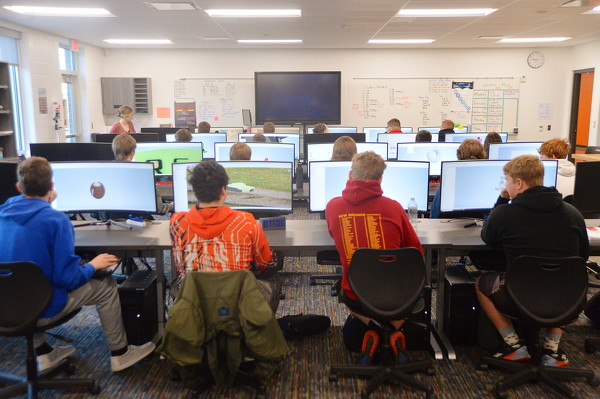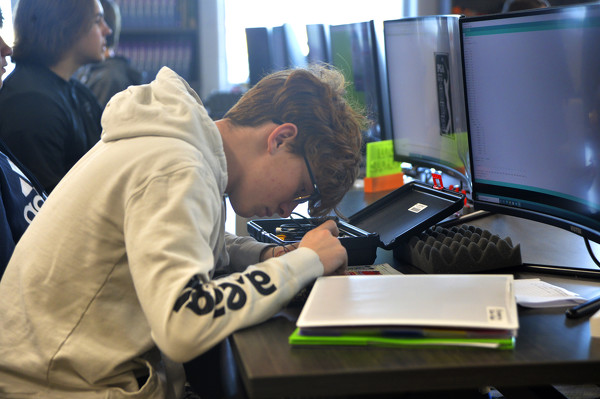Thursday, March 24th, 2022
Tri Star program retooled
Engineering tech enrollment up
By William Kincaid

Photo by Paige Sutter/The Daily Standard
Tri Star engineering students draw designs using AutoCAD, a computer-aided design software that is used for 2D and 3D drafting.
CELINA - Tri Star is retooling its Engineering Technology program to meet the needs of students and area businesses who may hire them once they graduate.
Instructor Taylor Hesse this school year expanded it into a two-year program to cultivate a broader education with applicable work opportunities at local businesses.
Hesse, a Parkway High School graduate and former FFA student, has a strong background in robotics, machining and welding, said Tri Star Director Tim Buschur. She also has a bachelor's degree in technology education from Ohio Northern University and is working toward a master's degree and Career Technical Education Certification through the University of Toledo, according to her Tri Star biography.
Now in her second year, Hesse's proven to be an excellent choice to retool one of Tri Star's heritage programs. Over the years is has also been known as computer-aided design or CAD, Buschur said.
Enrollment in the program has skyrocketed.
It's jumped from eight students during Hesse's first year running the program to 28 students - 19 in the morning session and nine in the afternoon - this school year. A total of 38 students have signed up for the 2022-2023 school year so far.
"She gets to build something, what her vision is, and just coming from out of college, she knows what kids want," Buschur said.
Hesse said she's the third instructor to lead the program after Jon Clouse and Keith Westrick.
"Prior and last year, the program was just a one-year program. This year we moved it to a two-year program," she said.
Many years ago the program was cut from a two-year to a one-year program due to the number of Advanced Placement classes and other coursework students had to take at their home schools which greatly constrained their time.
"Now with all the online stuff they can do and the College Credit Plus and they're starting to take college credit classes in middle school, all that stuff, they have time now," she said. "So we found that students can commit the two years and it works out great for them to do that now."
The overall aim of the program is to instill in students a broad understanding of engineering.
"A lot of them sign up, maybe they think they want to be engineers. Some have no idea. (It) just kind of gives them an idea," she said.
Those who find engineering to be a career path can hone in on a particular field about which they're passionate, get hands-on experience from local employees and consider colleges after graduating.
Year one mostly consists of juniors who are exposed to fundamentals of various forms of engineering. Year two is for seniors who spend half of the year working on a capstone project and the other half working for local businesses such as manufacturers, building supply companies and others.
"They need the workers and if the kids know what they want to do, why not work?" Buschur said.
"I mean, you still want them to be kids but a lot of kids like to work and this is the perfect thing. They work four days a week, sometimes five, they're making money and they go to school to do their sports or band or other stuff - and they know what they want to do," Buschur said.
Hesse embraced the task of growing the program by first sticking to traditional fundamentals.

Photo by Paige Sutter/The Daily Standard
Skyler Fokine of Celina hunches over while carefully wiring a circuit board during an engineering class at Tri Star in Celina.
"When I took over I kind of adapted and changed some of the curriculum. So we still do all the traditional stuff that people think of, kind of more of the mechanical engineering," Hesse said. "But I also added after Christmas, when the juniors come back, they now do electronics and electrical."
Essentially, Hesse wants the kids to have a basic understanding of electricity and how it powers applications, tools and processes.
On the civil engineering side, students use Revit software to design houses and buildings. Revit is the same tool used to design the new $25 million Tri Star facility on State Route 703.
"They get to put washers and dryers in them and different beds in them and change the brick and change the paint and put different flooring in and put windows in and doors," Hesse said.
Students have access to the Inventor and Autocad software programs, and 3D printers and laser engravers, to learn about mechanical engineering, she said.
"They create projects on there. I want them to get the basics of drawings and making drawings and prints," she said. "We use our 3D printers with that so it's kind of cool for them to see it come to life. It's more than just drawing, that 3D image on the computer."
Hesse also emphasizes soft skills, noting that some may have a misconception of engineers as people who sit behind computers isolated from others.
"So I definitely want to get these guys to be able to do good interviews and get resumes and problem solve and communicate," she said.
Second-year students spend August through December working on their capstone projects, basically anything they want to create within reason. One student who shows animals at the fair designed an animal feeder that he made with a plasma cutter in the welding program.
Another made a functioning remote-control car.
"He printed all of the parts off of the 3D printer besides the electronic parts, obviously," Hesse said.
The second half of the year the students head to work for most days except for usually every other Monday when they attend class.
"So far it's been great. The businesses (employing students) have been great this year," she noted.
It's up to the companies to decide how to best put the students to works.
"But most of them have started them up in the engineering role. They've given them projects," she said, pointing to tasks such as organizing and inventorying tools and designing new office spaces with Revit.
Some business officials said they often forget they're dealing with high school students because of the college-level work they're doing.
Looking to the future, Hesse said she plans to incorporate the Lake Campus, just a stone's throw away from Tri Star, into the program more.
"I try to get the kids in there and most of my seniors this year are looking at the Lake Campus, which is great, nice and close for them," she said.
She also welcomes additional student work opportunities and class speakers for next school year.
"We're definitely going to need more businesses," she said.
There are no prerequisites but it might be helpful for students to take an engineering class or geometry at their home school before enrolling in the program, Hesse said.

